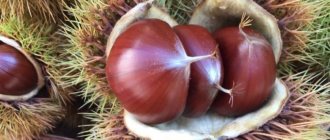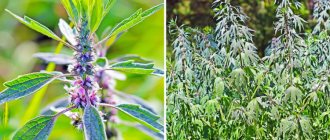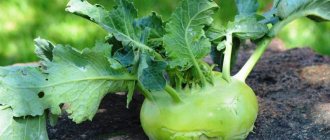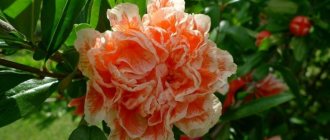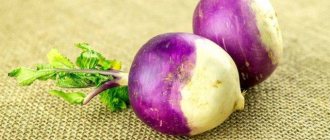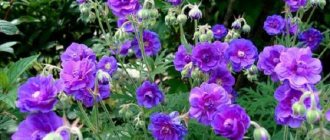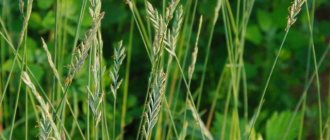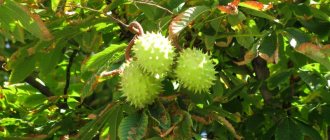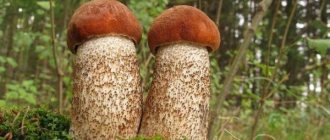People have known about the healing effects of chestnuts since ancient times. This is a small genus of spreading trees native to the southern regions. The fruits of the plant are endowed with a colossal list of useful compounds and elements that few people are aware of. People are accustomed to eating them and preparing sweet desserts from nutritious nuts, without even realizing their healing power. Scientists know thoroughly that all parts of this amazing tree are endowed with a huge bouquet of useful ingredients.
The fruits, flowers, seeds, bark and leaves of the edible chestnut are widely used in alternative medicine. Official science has proven the therapeutic significance of all components. In this material, space is given to green leaves bordering the crown of the tree. You will gain useful information about its properties, uses, and also learn how to prepare healing decoctions.
What do chestnut leaves look like and when to collect them?
Biologists know over 30 varieties of chestnut tree populations. The most popular is the sowing variety, suitable for consumption. Each subspecies differs in fruiting and trunk height. Healers often use seed chestnut for medicinal needs. It can be distinguished by its oblong, slightly pointed leaves, 25 cm long.
During the blooming period they become rich red. Chestnut leaves turn bright yellow in autumn. From August to September, experienced healers begin to reap the “harvest.” The raw materials are laid out in an even layer on a fabric surface, periodically turned over for the first few days to dry evenly. Then they are transferred to containers and stored for 12 months.
Everything in a tree should be impressive.
The attention to his person is not surprising; even in warm Europe, where tree diversity is great, horse chestnut is valued as an outstanding park tree. A powerful, stocky trunk, with muscular branches extending obliquely upwards, also contributes to its appearance; and large five- to seven-fingered leaves, up to 25 cm in diameter. The bark of young trees has an attractive grayish-beige color with brown spots. Even small chestnut seedlings look extremely impressive: their shoots are unusually thick, and their buds, similar to the tops of medieval spears, are reputed to be the largest in the tree world. The tree as a whole also looks extremely impressive, with a mosaic of leaves up close and the silhouette of a crown from afar. And even in winter, the chestnut is unusually impressive with its massive trunk and unique graphics of the branches. It should be mentioned that a mature chestnut tree in Europe reaches 25 meters in height and in a mature state in open areas has an umbrella-shaped crown raised to a low standard. In our middle zone it is no longer so large, and 15 m is the limit for it. Even further north, chestnut can take the form of a low (5-6m) multi-stemmed tree.
The trunk of a maturing tree gradually becomes bare from below, so that you can walk freely under its crown. The crown itself is evenly thick, and a fleeting downpour will simply drain from it like over a roof, leaving you dry. If, standing at the foot, you look up, you can trace the entire trunk almost to the very top. This is because the main part of the leaves is located along the periphery of the crown.
Components
Chestnut leaves are endowed with amazing substances that improve human health. Experts have identified triterpene compositions that play a key role in metabolic processes, tannins necessary for the body to fight free radicals. Pectin substances have been discovered that help eliminate toxins and heavy metals. One cannot fail to mention flavonoids: they have a positive effect on the enzyme system. They abound in plant glucose, organic acids, lecithin, and a wide range of vitamins and microelements.
Chestnut leaves in folk medicine: a pantry of health for humans
The plant is widely appreciated for its taste and healing powers. The medicinal abilities of parts of the tree are used by folk doctors around the world. Chestnut fruits and leaves have the following properties:
- antitussive;
- astringent;
- diuretic;
- anti-inflammatory;
- wound healing;
- antipyretic.
Such an extensive list of beneficial effects is explained by the presence of a vitamin and mineral complex. Official pharmaceuticals have recognized that the plant can cure a number of diseases. In pharmacy chains you can find a lot of drugs based on chestnut leaves. Extracts and decoctions effectively relieve swelling and stabilize blood pressure.
Such drugs exhibit analgesic effects. Infusions normalize the condition of the intestinal tract. They also thin the blood, make the walls of blood vessels more elastic, and increase their permeability. Prevents the formation of cholesterol plaques. Plant raw materials are used to combat respiratory pathologies: it stops the cough reflex, improves the viscosity of sputum. The drugs help stop uterine bleeding.
For cough and whooping cough
For 10 grams of dry raw materials (pre-grind), take a glass of hot water. Bring to a boil, leave for an hour. Filter and drink the day before. Or consume a large spoon three times a day for two weeks.
Before taking chestnut leaves, you should consult a specialist. The plant is contraindicated in case of individual intolerance.
Chestnut is a luxurious tree that often decorates parks and squares. In summer it pleases the eye with its elongated green leaves, and in autumn its fruits begin to ripen. All chestnut trees belong to the cedar family.
If there are suitable conditions, you can grow such a tree on your site. The medicinal and taste properties of chestnut leaves and fruits have been known for a long time. It is important to know how to properly prepare and eat them - or as medicine.
Description of horse chestnut
The height of this deciduous tree can reach up to 25 m. There are chestnuts that look like spreading, perennial shrubs, no more than 1.5-2 m in height. Their leaves are large, oblong in shape.
The tree's flowers are shaped like bells. They are located asymmetrically and have a tart but pleasant smell. There are many varieties of horse chestnut. Depending on the species, flowers can be of different shades. Most often, they are large, white, interspersed with pink or red. If you look closely at them, you will find that they look like antique candles. Their diameter can be up to 2 cm. In the southern regions, chestnut flowers can be:
- red;
- beige;
- white;
- bright pink.
Large flowers form pyramidal-shaped inflorescences, with tassels arranged vertically. The calyx of each flower has five sepals, which grow together closer to the base. The filaments of the stamens are long, bent, the pistil is formed by three carpels.
When the chestnut tree fades, it puts on another outfit, no less beautiful than its flowers. Chestnut leaves turn different shades in autumn. They can be yellow, purple, purple-red and brown. The rich colors of the foliage attract the attention of people who take beautiful photos of these majestic trees. When fruits appear on an autumn chestnut tree, many people think about how healthy and tasty they are.
The fruit of the horse tree looks like a round green box. Its length is from 6 to 8 cm. In appearance it looks like a small green hedgehog covered with prickly needles. Each fruit has three opening flaps and can contain from 1 to 4 nuts. Chestnut fruits ripen in autumn, their ripening time is September and October.
Where does chestnut live?
The birthplace of this tree is considered to be Europe or Australia. Experts have described about 30 species of chestnut trees. They can be found in different parts of the world:
- in France;
- in Spain;
- in Italy (and the Alps);
- in Croatia;
- in the Balkans;
- in the southern district of Switzerland;
- in the Caucasus;
- in Asia Minor;
- in Persia;
- in South Africa.
Chestnut also grows in North America. It feels best in a temperate climate, on loose and nutritious soil.
It is known from history that the horse chestnut tree was first brought to Constantinople in 1557. After this, it was transported to Austria, from where it quickly spread across the European continent. In Russia, chestnuts are cultivated in St. Petersburg, Moscow and other cities. Chestnuts are resistant to the harsh conditions of large cities, so they are most often used for large group plantings.
During the first ten years, chestnut growth is slow. They experience a period of intensive growth between the ages of 10 and 25 years.
Flowering time
Like other trees, chestnut begins to bloom in the spring, but much later than them. In May, its buds swell and the first “bells” appear. May flowering is a great advantage for the tree. It helps flowers avoid spring frosts, so chestnut nuts always ripen on time. Flowering duration is from 2 to 3 weeks. After this, bright green nut ovaries appear, which finally ripen by autumn.
Chestnut in landscape design
Chestnut can be planted separately or a group planting of these trees can be organized. Chestnuts are often decorated with:
- streets;
- big roads;
- garden paths;
- park alleys.
What type of trees get along well with chestnut? These are spruce, pine and other types of conifers. It is also planted near birch or acacia trees. Gardeners often place a single chestnut tree in the middle of a large lawn or large clearing. When it grows, people escape from the scorching rays of the sun in its large shade. A relaxation area will fit perfectly under the majestic crown: you can place a sun lounger, a hammock or a table with benches nearby.
Chestnut trees appeal to many gardening enthusiasts, but not every site is suitable for planting them. If this is a small summer cottage plot of 6 to 12 acres, it will not be suitable for planting chestnuts. These trees have a powerful root system that needs a lot of space. Chestnuts are unpretentious to watering and care: for their successful growth, simple agrotechnical measures will be enough.
Planting a seedling
The chestnut root system has an interesting feature - it is superficial. Therefore, after choosing a good place, you still need to prepare the soil so that the tree is comfortable.
High-quality drainage is needed: a layer of sand or a mixture of sand and clay should be placed in a prepared hole up to 60 cm deep. This is done to prevent the roots from rotting: stagnation of water is detrimental to chestnut.
Most often, horse chestnut is planted in the fall. Alternatively, it can be planted in early spring. When planting, it is important to make sure that you do not bury the root collar in the ground - it should be at soil level. As soon as planting is completed, it is necessary to water the seedling abundantly (at least 3 buckets of water per 1 tree).
While the tree is very young, it can be damaged by an animal or wind. To prevent this from happening, you need to install supports on four sides.
Chestnut nut and its uses
Chestnut nuts contain starch. They are also rich in fiber, glucose and vitamins. There is almost no fat in this nut, but it is very rich in carbohydrates. There are about 60% of them in its composition. In addition to carbohydrates and fats, chestnut nuts contain proteins. The product is generously enriched with minerals:
How to cook nuts correctly
Cooking chestnut nuts is easy. It is important to know how to prepare them correctly. The skin of each nut is carefully cut and placed in boiling water. After 3 minutes, they are removed and cleared of film.
After the preparatory activities, start cooking. The nuts are poured with cold water and boiled for 20 minutes. When the fruits become soft, drain the water, wrap the saucepan with a warm cloth and leave for 5 minutes. All that remains is to add a little butter to the dish, and the boiled chestnuts can be served.
Meat sauce
The fruit must be peeled in the same way as before cooking. After this, they need to be placed in meat broth and boiled in it for about 15 minutes. After softening the nuts, mash them with a blender or using a masher. The finished sauce is flavored with nutmeg, cream or butter. You can add a little salt to it.
Autumn chestnut dessert
The nuts are cleaned and pre-processed, then dipped into a boiling mixture of milk and sugar. After the fruits have softened, they are finely chopped or pureed.
The natural power of nuts
You can cook more than just delicious dishes from chestnuts. People have been using their amazing natural power for a long time. Healers believe that gentle massage with a small nut helps with mastopathy. The majestic chestnut is popularly revered as a sunny tree. That is why people carry its fruits in their pockets, fueled by inexhaustible natural power.
Harvest storage
Ripe fruits contain a lot of moisture. If you leave the harvested crop stored at room temperature, it will disappear in a few days - it will become moldy and rot even in the shell.
To preserve the freshness of nuts for as long as possible, they should be placed in the refrigerator or in a dry cellar . Recommended air temperature: no more than +3 °C. You can put the nuts in boxes and cover them with dry sand, like potatoes or carrots. Paper or linen breathable bags are suitable. Cellophane cannot be used. Pre-roasted or boiled nuts can be frozen. If all requirements are met, chestnuts will last up to 6–7 months.
What is rich in the autumn chestnut leaf?
Chestnut leaves contain vitamins B and C, but these are not all the substances they contain. Scientists have identified several complex triterpene compounds that help improve metabolism. Tannins contained in chestnut leaves have a general strengthening and antiseptic effect. Pectins remove toxins and other breakdown products from the body. Also, the autumn chestnut leaf contains flavonoids. Flavonoids are substances that stimulate the synthesis of natural enzymes. In addition, the foliage contains glucose, lecithin, organic substances, trace elements and vitamins.
Foliage of other varieties may not be suitable for medicinal use. Cultivated chestnut is common in many regions of Russia. It is distinguished by the appearance of its foliage. It has an oblong shape and is slightly pointed at the ends. The foliage length of seed chestnut is about 25 cm.
The collection of chestnut leaves for medicinal use begins in August and ends at the end of September. The material should be evenly laid out on a cloth to dry. During the first days of drying, the leaves need to be turned over so that they dry evenly. Dried leaves are placed in dry containers and used throughout the year.
Planting chestnut step by step
In order for the chestnut to bear fruit consistently and not get sick, it is recommended to choose a suitable place for it and prepare healthy planting material.
Selection of planting material
Three-year-old seedlings are selected for planting. It is believed that it is at this age that the plant is best suited for planting in open ground. Chestnut is not as popular a crop as apple or pear, so summer residents buy seedlings in special nurseries. It is important that the plant has a healthy appearance, strong light brown bark and developed shoots.
Attention! To plant a chestnut, prepare gardening tools: a shovel, a rake, a bucket of water, a metal peg (the future support of the tree).
The roots should be long and spread out to the sides. They should not be mixed up, have stains, traces of mold or rot. It is recommended to ask the seller for which regions the plant is suitable, how it behaves when climatic conditions change, and in what year the first harvest occurs.
What to do
For a young tree, prepare a hole measuring 60x50 cm. It is advisable to give it a square-round shape so that there is free space for the development of the root system.
A drainage layer 20–30 cm deep is laid on the bottom, and a mixture of dolomite flour and soil is added.
The seedling is carefully placed at the bottom of the planting hole, sprinkled with loose soil and watered abundantly. You can build supports from wooden pegs, but after 1 year replace them with metal ones.
Chestnut leaf in folk medicine
Chestnut foliage has a number of beneficial properties. It relieves cough and is an excellent diuretic. It is used for various types of inflammation, including for the purpose of wound healing. They help with many conditions:
- high blood pressure;
- infectious diseases accompanied by high fever;
- swelling;
- pathologies of the gastrointestinal tract;
- respiratory problems;
- pathologies of the hematopoietic system.
The wide spectrum of action of chestnut foliage is due to the fact that it contains many vitamins and minerals.
Healthy tea for varicose veins
Chestnut leaf tea can reduce the signs of varicose veins. The crushed raw materials are poured with boiling water in a ratio of 1:15. Tea is infused in a thermos for 4 to 5 hours. To achieve a therapeutic effect, drink 400 ml of tea 2-3 times a day.
For bleeding from the uterus
Dry chestnut leaves will help women with uterine bleeding. A handful of raw materials is stirred in a glass filled with hot water, then boiled in a saucepan for 10-15 minutes. The broth is cooled to room temperature, then filtered through a sieve. You need to drink little by little: 10 ml of liquid 5 to 6 times a day.
Infusion for lipoma (“fat”)
You need to prepare an infusion for taking a bath. You will need a large 10 liter bucket. Dry leaves are placed in it, poured with boiled water and left for a day. After infusion, the solution is filtered and poured into the bath. You need to take a bath for 15 minutes, repeating the procedure after 2 days. The course of treatment is two weeks.
Cough remedy
To get rid of cough, you need to take 10 g of dry chestnut leaves and finely crush them. Pour a glass of hot water over the leaves, bring to a boil and leave for 60 minutes. After infusion, the liquid is filtered and drunk little by little throughout the day. You can also take this infusion one tablespoon three times a day. The course of treatment is 14 days.
The fruits and foliage of autumn chestnut have long been used in folk medicine and cooking. If you know the rules for using such raw materials, they will always bring health benefits.
12.10.2018
Chestnut
, or
European
- S. sativa Mill
Naturally grows in the Mediterranean and Black Sea regions of Asia Minor, in Western Transcaucasia and the Northern Caucasus.
Photos of Natalia Pavlova
Slender, majestic tree up to 35 m tall, with a regular ovoid or oval crown. In young plants, the trunk is straight, smooth, later covered with a dark brown crust with deep longitudinal cracks. In beauty, growth power and durability it can compete with oak. The shoots are reddish or olive-brown, ribbed, with numerous glandular hairs.
Photo by Sergei Adamchik
The leaves are beautiful, large, up to 25 cm, oblong-elliptic or lanceolate, pitted-serrate, often with crescent-shaped teeth; naked above, grayish or yellowish below with abundant stellate hairs. In youth, the leaves are reddish, pubescent below, in summer they are yellowish-dark green, in autumn they are bright yellow. Male inflorescences are spike-shaped, erect, dense, yellowish, up to 35 cm long, with bracts. The female flowers are greenish, in short, few-flowered, spike-shaped inflorescences. Flowering lasts about a month. Based on the nature of flowering, early and late flowering forms are distinguished. During flowering time they are very spectacular.
Growing conditions
The distance between plants in groups and alleys is at least 5-6 m.
The root collar should be at ground level after the soil settles.
Soil mixture:
Turf soil, humus, sand - 2:1:1.
Add 100-200 g of slaked lime to the planting hole.
A drainage layer of 10-20 cm of crushed stone is required.
Optimal acidity - pH 6-7.5
Feeding:
In early spring, add at the rate of dilution in 10 liters of water: mullein - 1 kg, urea - 15 g, ammonium nitrate - 25 g. In early autumn, 15-20 g of nitroammophoska.
Watering:
Mandatory upon landing and in the next 3-4 days.
It tolerates short-term drought relatively well, however, during dry periods of spring and summer, watering is required at the rate of 1 bucket per 1 sq.m of crown projection.
Young plants require more frequent and abundant watering during dry periods.
Loosening:
Mandatory for removing weeds and aerating the soil.
Mulching:
Mulching the tree trunk circle with peat, peat compost, wood chips in a layer of 8-12 cm.
Trimming:
Cutting out drying branches and clearing the trunk of shoots.
Pests:
Diseases:
Preparing for winter:
In young plants, the trunk circles are sprinkled with fallen leaves.
To protect against frost damage, standard plants must be covered for the winter in the first 2-3 years after planting, wrapping the trunk with burlap in 1-2 layers. If frost holes do appear, you need to treat them with any antiseptic and cover them with garden varnish.
| Eating | |
| Notes | The fruits can be fed to domestic animals, especially horses, in small quantities. Pigs and goats also feed on the fruits. |
WHAT COLOR ARE CHESTNUT LEAVES IN AUTUMN?
There are also a lot of these trees in Dneprodzerzhinsk. Injections - to trees, leaves - disposal So far, the only effective way to protect chestnuts from the pest is injections into the tree trunk. It was invented by Polish scientists. In early spring, they inject the trunk of the chestnut tree with a chemical substance that inhibits the development of moth eggs. One injection, according to the environmental inspection of Dneprodzerzhinsk, costs thirty US dollars. True, on the Internet you can find drugs that cost one hundred hryvnia per injection. A similar method for saving chestnuts was developed at the Institute of Plant Protection of the Academy of Sciences of Ukraine. It consists of the following: a drug concentrate is injected into tree trunks using a special device. About 20 injections are given to the tree in a circle, and the injection site is covered with a special composition. During this procedure, it is important to maintain maximum sterility to avoid moisture and microbes, otherwise the trunk will rot. The healing effect lasts for two years. Since the pest overwinters in fallen leaves, there are two approaches to how to use it to combat it. You can leave leaves under trees without raking them into piles, in the hope that winter frosts will kill the miner. However, experiments have shown that the pupae can withstand short-term cooling down to ten degrees below zero. Another approach is to collect the leaves, haul them away and dispose of them. However, burning leaves poses a threat to human health. There is evidence that the insect dies when leaves are composted in closed pits, for example, under a layer of soil. Perhaps specialists should pay attention to this method of disposing of fallen leaves. BY THE WAY: The pest is known by several names: Balkan moth, Macedonian gray or leaf miner, Ohrid miner, in Latin - Cameraria ohridella. It was first noted in Macedonia in 1985. in the area of Lake Ohrid. At the moment, its source of origin is unknown. The natural enemies of the miner are also unknown, that is, those who hunt it or limit its distribution in nature.
Chestnut
, or
European
- S. sativa Mill
Naturally grows in the Mediterranean and Black Sea regions of Asia Minor, in Western Transcaucasia and the Northern Caucasus.
Photos of Natalia Pavlova
Slender, majestic tree up to 35 m tall, with a regular ovoid or oval crown. In young plants, the trunk is straight, smooth, later covered with a dark brown crust with deep longitudinal cracks. In beauty, growth power and durability it can compete with oak. The shoots are reddish or olive-brown, ribbed, with numerous glandular hairs.
Photo by Sergei Adamchik
The leaves are beautiful, large, up to 25 cm, oblong-elliptic or lanceolate, pitted-serrate, often with crescent-shaped teeth; naked above, grayish or yellowish below with abundant stellate hairs. In youth, the leaves are reddish, pubescent below, in summer they are yellowish-dark green, in autumn they are bright yellow. Male inflorescences are spike-shaped, erect, dense, yellowish, up to 35 cm long, with bracts. The female flowers are greenish, in short, few-flowered, spike-shaped inflorescences. Flowering lasts about a month. Based on the nature of flowering, early and late flowering forms are distinguished. During flowering time they are very spectacular. The fruits are large, edible nuts with a leathery, glossy chestnut-colored pericarp, with a wide white spot at the base, arranged 1-3 in a common wrapper, lined with spines.
It grows quite quickly, is shade-tolerant, and requires heat and moisture. Does not tolerate drought and low temperatures well. Prefers sour, brown, forest loams. Reacts negatively to high lime content in the soil. Withstands pruning and replanting well. Durable. Lives up to 500 years or more. In Italy, trees up to 3000 years old are known. Propagated by seeds, root shoots, grafting (forms). Seeds are stored for spring sowing in semi-moist sand, for autumn sowing - in bags in a dry, unheated room. Germination rate c. remains until the spring of next year. Soil germination s. up to 50 %. Embedment depth c. 6 - 8 cm. Often damaged by rot, especially old trees.
Photo by Sergei Adamchik
One of the most beautiful deciduous trees, with a slender trunk, regular rounded, dense, light green crown and large ornamental foliage, turning pure yellow in autumn. Very effective in single and group plantings, alleys, areas and streets. When properly shaped, it can be used for tall hedges and walls. In culture since ancient times.
Reproduction
Chestnut can be propagated both by seeds (nuts) and cuttings. The first method is longer and more complex, so gardeners usually prefer cuttings. Well, or they buy ready-made seedlings straight away from the nursery. Let's briefly get acquainted with the features of cuttings and seed propagation of chestnuts.
Cuttings
Planting material, that is, cuttings, is prepared in the fall. By the time of harvesting, the bark and wood of the mother plant should be sufficiently mature, and the buds should be formed. Cuttings are cut 20-30 cm long: each of them must have at least 5-7 buds. In winter, cuttings are stored in boxes with sand and rooted in spring.
Seeds
For a nut to hatch, it must be completely ripe: green or, conversely, rotten specimens will not be suitable. Take those seeds that fell to the ground on their own: they are guaranteed to ripen. But it is important that the skin of the nuts remains intact, otherwise rotting is likely.
Nuts will be able to germinate only after stratification: the procedure should be carried out naturally, in a pile of fallen leaves. In such a pile, the nuts must overwinter in order to harden, become saturated with moisture, and then sprout safely in the spring.
But this is in natural conditions. In our case we are talking about artificial, cultural reproduction, and therefore stratification is usually carried out artificially. For this purpose, nuts are collected at the end of autumn and soaked in water for five days, changing it periodically.
The procedure softens the nut shells, making it easier for them to germinate in the future. After stratification, the fruits are planted in a box or on a bed to a depth of 10 cm. The top of the planting is insulated with dry leaves. Chestnuts should overwinter in the ground outside: in the spring, many of the planted nuts will sprout.
The world around us, grade 1 How to paint leaves in summer and autumn colors?
In 2007, Evgeniy Kolishevsky, executive director of the environmental public organization Voice of Nature, spoke about the possible cause of the mysterious chestnut disease. Then, for the first time in our city, the name of the pest was heard - the Balkan moth. Pyotr Podgorodetsky, who then headed the Zelenstroy enterprise, said that he knew nothing about such a pest. City authorities are still keeping silent about a city-wide problem. Indeed, today the pest has already affected almost the entire chestnut population in Dneprodzerzhinsk. However, a similar problem has been encountered almost everywhere in Ukraine since the 90s of the last century. Massive destruction of chestnuts by the pest also occurs in other European countries. The 2001-2003 UNESCO program aimed at combating the Balkan moth did not produce tangible results. Experts admit: a mortal threat looms over the entire horse chestnut population today. Early leaf fall, according to the Institute of Zoology of the National Academy of Sciences of Ukraine, complicates the wintering of chestnuts and leads to the death of trees. The danger of the pest is also that it can feed on maple and alder leaves. There are also a lot of these trees in Dneprodzerzhinsk. Injections - to trees, leaves - disposal So far, the only effective way to protect chestnuts from the pest is injections into the tree trunk. It was invented by Polish scientists. In early spring, they inject the trunk of the chestnut tree with a chemical substance that inhibits the development of moth eggs. One injection, according to the environmental inspection of Dneprodzerzhinsk, costs thirty US dollars. True, on the Internet you can find drugs that cost one hundred hryvnia per injection. A similar method for saving chestnuts was developed at the Institute of Plant Protection of the Academy of Sciences of Ukraine. It consists of the following: a drug concentrate is injected into tree trunks using a special device. About 20 injections are given to the tree in a circle, and the injection site is covered with a special composition. During this procedure, it is important to maintain maximum sterility to avoid moisture and microbes, otherwise the trunk will rot. The healing effect lasts for two years. Since the pest overwinters in fallen leaves, there are two approaches to how to use it to combat it. You can leave leaves under trees without raking them into piles, in the hope that winter frosts will kill the miner. However, experiments have shown that the pupae can withstand short-term cooling down to ten degrees below zero. Another approach is to collect the leaves, haul them away and dispose of them. However, burning leaves poses a threat to human health. There is evidence that the insect dies when leaves are composted in closed pits, for example, under a layer of soil. Perhaps specialists should pay attention to this method of disposing of fallen leaves. BY THE WAY: The pest is known by several names: Balkan moth, Macedonian gray or leaf miner, Ohrid miner, in Latin - Cameraria ohridella. It was first noted in Macedonia in 1985. in the area of Lake Ohrid. At the moment, its source of origin is unknown. The natural enemies of the miner are also unknown, that is, those who hunt it or limit its distribution in nature.
What color are the leaves in the autumn
But due to the fact that in the 21st century the anthropogenic impact on the Earth’s biosphere has increased significantly, which leads to inevitable consequences. One of the consequences of this impact is biological invasions—the movement of plants and animals outside their natural habitats. The globalization of the economy, the transportation of goods by various modes of transport, and tourism have led to the fact that millions of tons of cargo are currently moved every second. Together with them, biological species also move outside their natural habitats - transported with raw materials, in containers, on water vessels, trolleybuses, etc. The result of such movements is the emergence of a new alien species of harmful entomofauna - the chestnut leaf miner (Fig. 2.1) or the Ohrid leaf miner. This pest poses a serious threat to horse chestnut trees. The chestnut moth overwinters at the pupal stage in a silky cocoon. In spring, females that have regenerated lay eggs on the upper side of the leaves of the lower tier of the chestnut crown. After rebirth from the egg, they penetrate into the epidermis of the leaf, where they feed on leaf sap, forming straight or slightly uneven passages along the veins of the leaf blades. When the caterpillar has sucked out all the sap, it begins to feed on the tissues of the leaves, forming deep and spatial brown stains filled with excrement and larval pests. Damage to green spaces by the chestnut leaf miner has a number of negative aspects. First of all, damaged chestnut crowns lose their natural decorative value, that is, trees with damaged leaves or completely without them pose a certain aesthetic problem for services involved in city landscape design. Among a number of measures to protect ornamental chestnut plantings in cities, at the present stage, the most accessible and highly effective is the toxication of tree crowns by injecting pesticides into tree trunks with the active substance imidoclocid. However, toxication of tree crowns in urban conditions creates a specific environmental hazard and requires careful timing to achieve the greatest effectiveness, which can only be determined by highly qualified entomologists. The most accessible measure to protect chestnut trees from the chestnut leaf miner is the autumn harvesting of fallen leaves with pupae overwintering in them. This method significantly reduces the number of butterflies that are reborn in the spring. However, it must be taken into account that cleaning fallen leaves is effective only when the leaf litter is removed from the places where chestnuts grow and is subject to disposal (composting, burning). As a last resort, the horse chestnut tree and the harvested leaves should be located at a distance of 50-100 m from each other. Ineffective and partial raking of leaves, since the presence of fallen leaves from one tree can reduce the results of combating it to nothing. In addition, autumn raking of leaves reduces fungal diseases of chestnut. Despite its incomplete effectiveness, as a preventive measure this method can be successfully used to reduce the pest population to a minimum or even completely destroy it for some time. However, there is no clear, highly effective system for protecting chestnuts in urban conditions in any of the sources.
Figure 2.1 – Common horse chestnut damaged by chestnut leaf miner
Date added: 2016-10-22; | Copyright infringement
| Photos of Natalia Pavlova | Photos of Natalia Pavlova | Photos of Natalia Pavlova | Photos of Natalia Pavlova |
